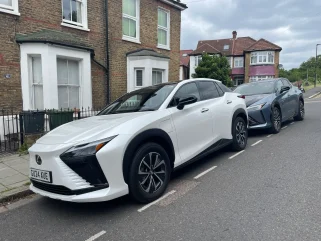
Final report: Yes to all-electric, front-wheel drive large Lexus
June seems like a long time ago, but it was then that our all-wheel drive, all-electric RZ large crossover arrived. A plan was hatched, half out of curiosity and half out of necessity, due to the front-wheel-drive variant only going on sale later in the year. The question was simple: what’s the better bet for company car drivers – more power and all-wheel drive with a slightly lower electric range for a higher price; or less power, front-wheel drive and a slightly longer range for a lower price?
We started with the 450e all-wheel drive (AWD) model launched in 2023 for a month and then swiftly swapped to a very early example of the 300e front-wheel drive (FWD) version in mid-summer which officially went on sale in autumn 2024. At 4805mm long the RZ is at the larger end of the all-electric crossover market, longer than the Audi Q6 E-Tron (4771mm) and shorter than the Mercedes EQE SUV (4863mm). It’s a big car, but we always liked its sharp and angular lines and smart proportions which hide its size well. The AWD’s bi-tone paint model – featuring a black gloss bonnet, door mirrors, roof, pillars, wheel arches and lower rocker panel against blue metallic bodywork elsewhere – was also a hit with most who clapped eyes on it.
Both cabins were calm-feeling spaces. On approaching the car with key in pocket, concave grab areas behind the exterior door handles lit up helpfully to guide the user to the opening mechanism and once inside, the main controls were all easily within reach, assisted by the large 14in central touchscreen angled towards the driver. The wide centre console features two shapely cupholders alongside a nicely knurled gear selector – with push down-and-left for Reverse and push down-and-right for Drive soon becoming second nature. Surrounded by matt grain wood veneer sloping gently down and away from the driver to a wireless charging mat for a smartphone with two USB-C ports above, there were connectivity options galore. Apple iPhone mirroring was easy for Carplay and wireless too, although Android Auto-compatible phones currently still need to plug in.
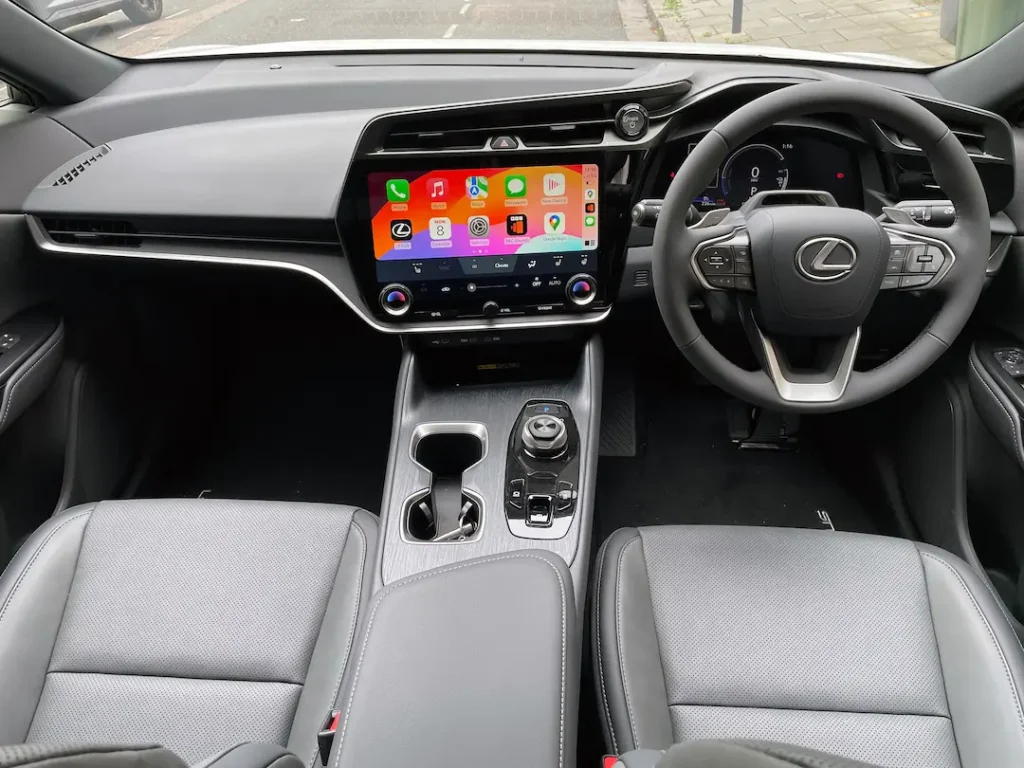
The car’s endless beeping for supposed safety issues was an aspect that needed speedy attention to switch off to avoid unsafe distraction though. For this driver, turning the Drive Assist function to ‘visual only’ rather than ‘visual and audible’ through the Settings section of the centre touchscreen was a ritual to be undertaken before every journey due to the (over) sensitivity of various alerts. If the Lexus user experience design team are reading this, please make any future facelift switch-off process a one or two-button process at most, or build it into a memory setting so as not to require starting afresh every journey. The current system requires far too many layers and repetition. The ambient interior door lights were jazzy too, but could do with highlighting the door buttons as well, for simpler departures for the unfamiliar.
Back to the positives, varied passengers in the rear seats reported very good levels of leg room and not bad shoulder room, even with three six-footers sat abreast. The fixed twin panoramic roof added to that feeling of space and light and the boot’s 522/1451 min/max luggage space seldom found us wanting more.
In daily life, the sprightlier 303hp 450e Premium Plus Pack with Bi-Tone paint at £64,640 P11D, might have been good for a 5.3-second 0-62mph sprint, but never felt that sporty or necessary. Plus its 252 official miles of electric range wearing 20in wheels (18in versions promise 272 miles) often made for a real-world distance of just over 200 miles. That isn’t great for a big car you might expect or need to go further. By comparison, all-hail the £52,240 204hp 300e in mid-range Premium 18in wheel trim. Although posting an official 8.0-second 0-62mph time, it didn’t feel much slower and offered a real-world 280-300 miles before re-charging (versus a 295-297-mile official range), plus a very credible 4.1 miles per kWh efficiency. Both the latter stats are very good indeed for a big EV.
Almost without exception then, the £12k cheaper and 50 miles longer range RZ FWD version feels like the smarter and more decent value package.
| Model | Lexus RZ 300e FWD Premium 18” |
| P11D price | £52,240 |
| As tested | £52,545 |
| WLTP Combined Range | 297 miles |
| Test consumption/Range | 4.1 miles/kWh |
| Mileage | 2,160 |
4th report: Long range good and IT improving
Three months into our RZ 300e long-term test, this man and his machine are feeling more harmonious. And I have no desire to go back to the more powerful all-wheel drive, but shorter range 450e. The front-wheel drive 300e has offered a solid and consistent 300 miles per 100% charge in the summer months which makes all sorts of longer journeys stress-free in a way that the 450e (with its 252 official and real-world 200-220 miles) never quite managed.
Recent one-day return missions to the Sussex and (deep) Essex coastlines from south London haven’t required a moment’s thought about charging along the way. Even a long circa four-hour business trip from Bentley back to home – some 180 miles – was also managed without recharging anxiety and averaging 4.5 miles per kWh – which is good for a big EV. The journeys have also been calm drives, with the 300e’s gentle suspension and easy steering inspiring relaxed confidence, while still able to get a little spirited on country roads. This is especially so with regen braking dialled up a few notches via the steering wheel paddles – left paddle for more regen and right paddle for less – as the net effect is a car that doesn’t run away with itself after bursts of acceleration and a driver that feels in control.
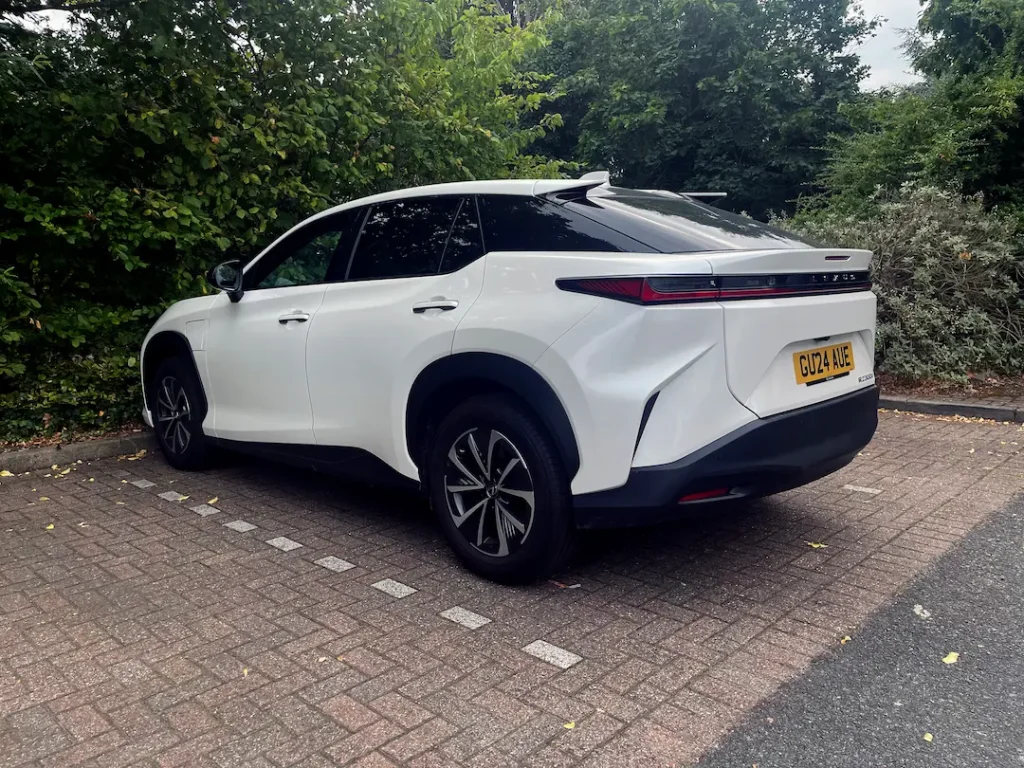
The higher brake regen levels are also handy at much slower speeds – to more easily keep within 20 or 30 mph zones for instance – although it’s been a boon to finally find out how to more easily turn off the car’s otherwise incessant beeping that accompanies any minor infringements of those limits, which is a big issue in 20mph zones so common in London. The audible beeping can be turned off within the somewhat ironically named ‘Driver Assist’ section of the car’s settings before every journey – leaving only the more helpful and less distracting visual speed limit signage displayed in the driver cluster. But turning that feature off before Apple’s CarPlay took over the screen was causing some stress. After much head-scratching and menu perusal, I gave up and contacted the press office to find out how to return to the Lexus system for that all-important ‘beep off’ switch (official name: ‘Excess speed caution options’). It turns out the shortcut is to press the Lexus logo button within Apple CarPlay to flip back to the car’s settings. When the Lexus settings have been adjusted the Apple CarPlay can be restored by pressing the sideways triangle ‘play’ button in the top right of the Lexus screen (as is usual). This is useful.
Also useful is the Lexus Link + app which I’ve downloaded to my phone after struggling with the basic Lexus Link app – which is still available for older Lexus cars but didn’t let me register without freezing. The newer Lexus Link + app is much better and links with the car in a two-minute process way easier and quicker than previous long-termers (Citroen, Volvo and more). Now I can see remotely, the state of charge, miles driven, miles remaining and lots more. All good.
The only outstanding IT issue on the RZ 300e is Apple Car Play’s inability to reply to texts or WhatsApp via Siri through the speakers. Annoyingly Siri pretends it can, asks what you’d like to reply and then fails, adding mysteriously and slightly pointlessly, “Sorry, I can’t show you the result while you’re in the car”. Another call to the Lexus PR reveals they know about the problem and it’s going to be sorted at the next software upgrade this autumn.
| Model | Lexus RZ 300e FWD Premium 18” |
| P11D price | £52,240 |
| As tested | £52,545 |
| WLTP Combined Range | 297 miles |
| Test consumption/Range | 4.5 miles/kWh |
| Mileage | 1,497 |
3rd report: Dear Shell… sort your public chargers out
Flippin’ eck. It really should be easier to charge an EV from a public plug in 2024. The same year by the way, that the Zero Emission Vehicle Mandate legislation (set up by the previous UK Government) is stipulating that every carmaker selling on these shores must reach a 22% EV market share by the 2024’s end, or face hefty fines (£15,000 per vehicle).
By and large, the product is there. Our latest Lexus RZ 300e long-termer is a good example, now offering front-wheel drive and a circa 300-mile real-world range between charges for a tad over £50,000. Not bad for a zero-emission large premium SUV that’s smooth and quiet around town and spirited and agile when required. And with loads of kit as standard.
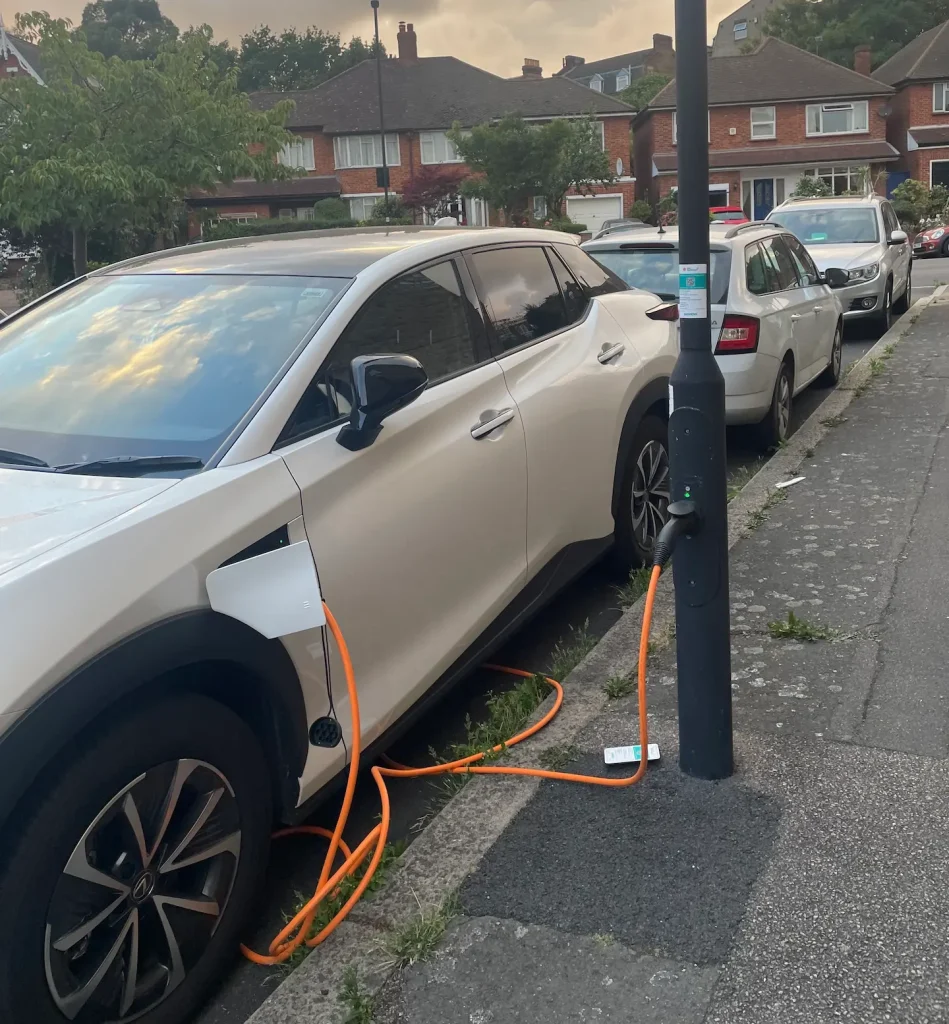
The trouble is the ramshackle local charging system that such EVs and their keen and early-adopting customers – plus yours truly, without off-street parking – has to contend with. The RZ 300e is now charging gently overnight as I write, but the process to get plugged in and started took a good half an hour, not a few minutes. And this was no ‘away fixture’ where I didn’t know the charging set-up or ‘lie of the land’ (as if that should make a difference). This was in my well-connected and highly-populated south London neighbourhood that already has a good number of EV owners without driveways.
Before I left my house I checked whether my nearest charger was free via ZapMap – which it was – so I quickly jumped in the car and mobilised to literally drive the 50 yards around the corner to plug-in. But by the time I got there, a pesky MG had nabbed the spot and had so freshly connected that the driver was still checking his phone by the car. Fair enough, that’s how it goes sometimes. It was another local EV driver I recognised who had the same idea as me and got there first. These things happen.
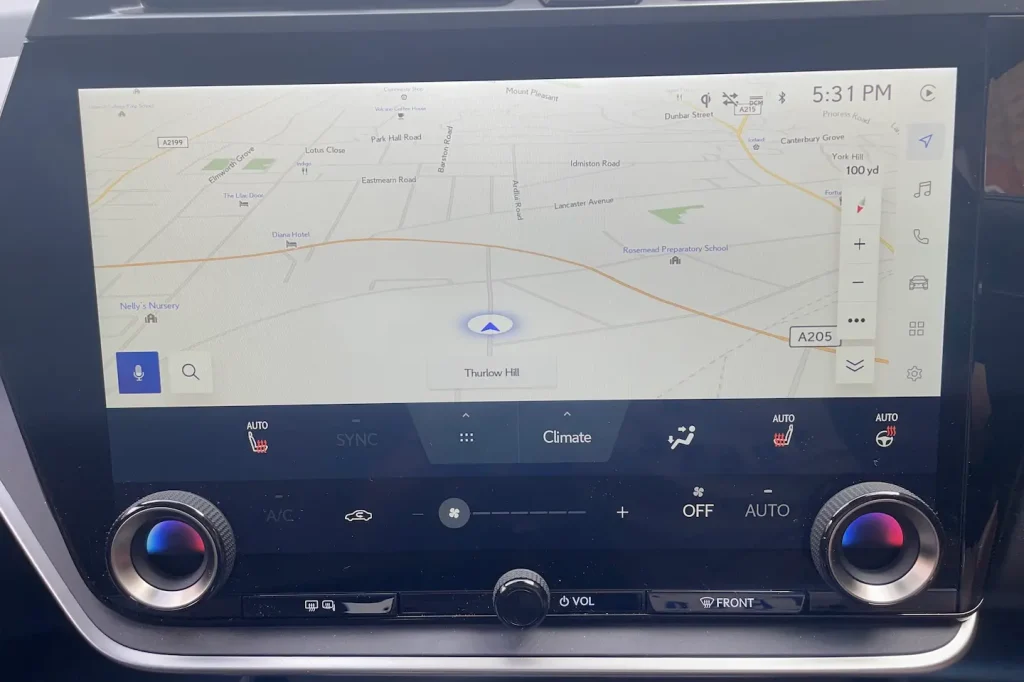
Undeterred, I drove around the nearby one-way system – negotiating some erratic buses, lorries and electric scooters – to the next free charging space 0.2 of a mile away, which was also free when I arrived and parked up. But clearly for a reason, as I discovered after I’d unbundled the cables from the boot. The sign for the Shell Ubitricity lamp post charger was missing so I had no QR code to scan to start the process. I thought there might be another way to get the website to start charging with my saved details, but seemingly not. So I rang the 0800 helpline which kept me on hold for more than five minutes before I gave up and drove on to a third nearby Shell Ubitricity charger which I found had had its plastic QR sign detached and on the floor by the lamp post, although it had at least been replaced by an official-looking sticker. Mindful of the current criminal scams for replacing QR codes to phish for credit card details, I checked the new sticker sign over with my fingers and it seemed kosher, so I proceeded to scan the QR code and try charging. Still on hold to the Shell Ubitricity helpline regarding the other charger, I gave up on after 19 and half minutes of being told their operators were busy.

Then, after some more wrestling of my phone, app and cables, the car and post both showed encouraging signs of charging with matching green lights. So I locked the car and started walking back to my house. In total, it ended up a 30-minute round trip, in order to add about 150 miles of charge overnight. This is nonsense. And I am an EV advocate of long-standing. Dear Shell, sort it out.
| Model | Lexus RZ 300e FWD Premium 18” |
| P11D price | £52,240 |
| As tested | £52,545 |
| WLTP combined range | 297 miles |
| Test consumption/range | 4.4 miles/kWh |
| Mileage | 1,239 |
2nd report: “Runaround now!”
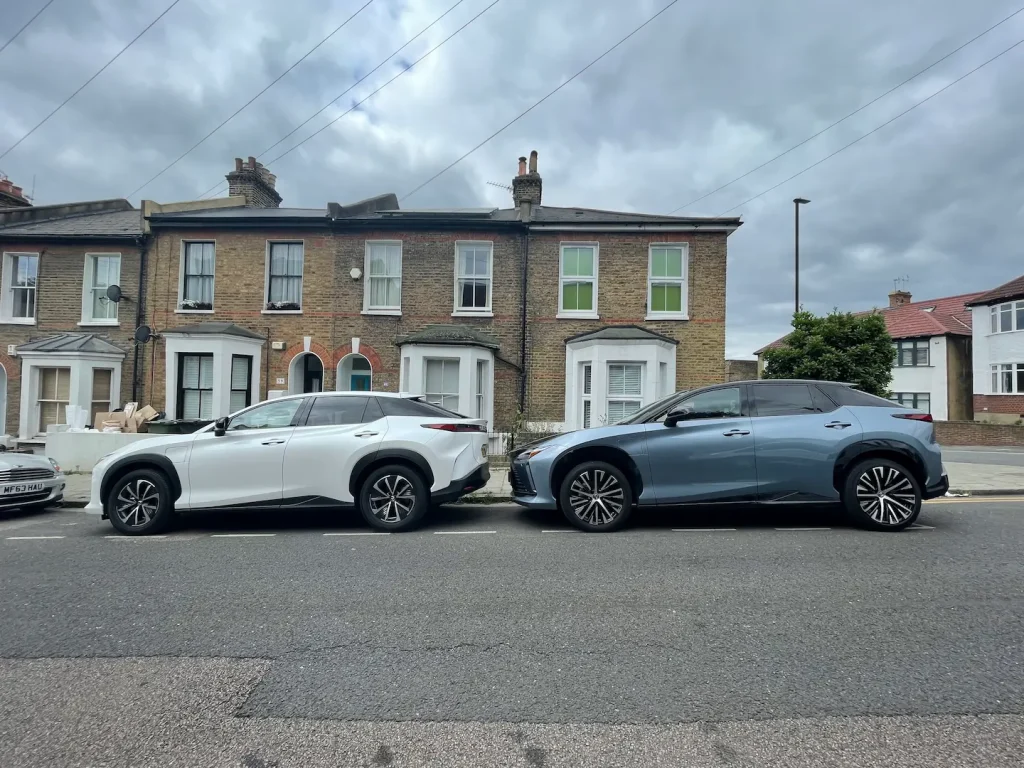
Readers of a certain vintage may remember the ITV kids’ game show Runaround that ran from 1975-1981 and featured the gravelly voice of presenter Mike Reid – who later played the legendary Frank Butcher in Eastenders. The name of the game involved contestants physically choosing a space to stand on the floor, related to their answer to an associated question, but with the late option to jump onto a different space, signalled by Mike, shouting in full cockney: “Run-a-rand…nah!” As you can probably tell, the phrase has stuck in my head as shorthand for a last-minute opportunity to change a decision… and is sort of what happened with our long-term Lexus. Except in this case, we planned the cunning change from the start.
We began our appraisal of the Lexus RZ with the 313hp 450e – to get accustomed to the all-wheel drive model on sale since 2023 – but then swapped it after only a month for the just-launching front-wheel drive 204hp 300e, which we now intend to stick with for the next six months. The on-paper differences between the two models are numerous and worth noting for potential fleet and business drivers.
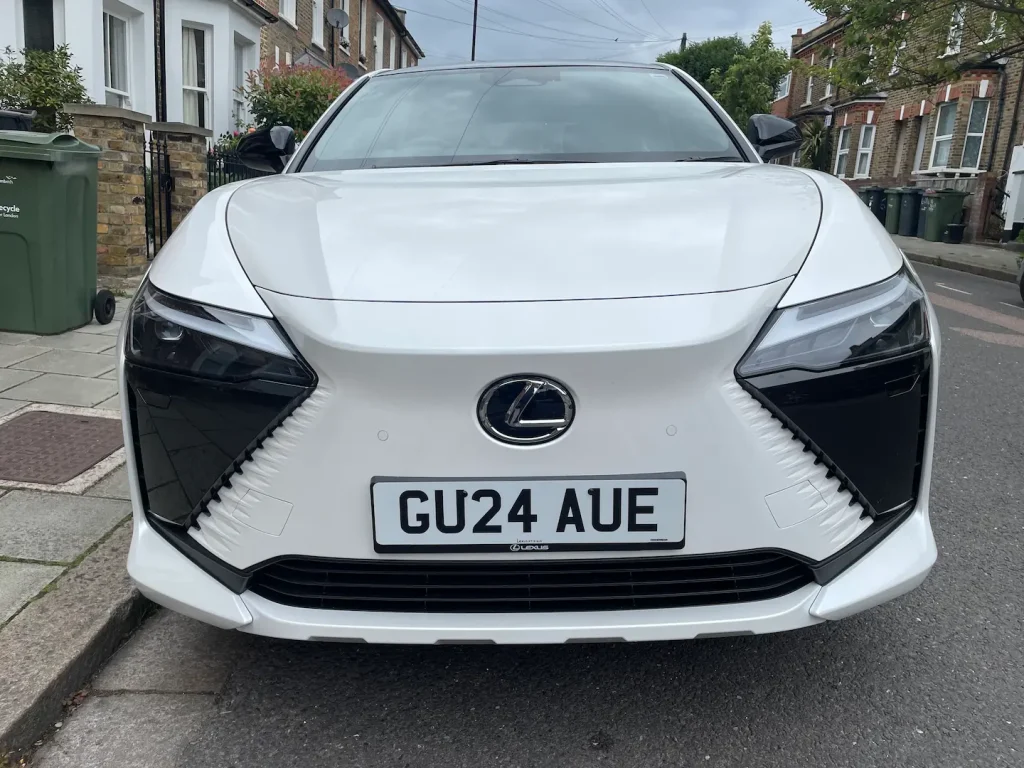
The 450e Premium Plus Bi-Tone trim is the more costly of the two at £64,695. But its striking two-tone paint – including a contrast black bonnet and roof to its otherwise blue bodywork – has caused a few random strangers to stop me in the street to enthuse about its unusual colour combination. The 450e is also more powerful and rapid (5.3secs 0-62mph vs. the 300e’s 8.0secs) and sports 20in wheels. That capability has been fun to test on longer and more open roads, but due to its greater accessory list and all-wheel drive, the 450e Premium Plus Bi-Tone also works out heavier at 2105kg, versus the 300e’s lighter 1995-2040kg range (Lexus hasn’t provided exact spec weight yet). And that affects how far you can travel.
The best figure we managed in the 450e after a charge to ‘100%’ was only 206 miles in clement conditions, compared to its official 252-mile range. That made a difference on a recent 200-plus-mile round trip, necessitating a one-hour fast-charging stopover added to an already long working day. By contrast, our new 300e’s official max figure is 297 miles, sitting on 18in wheels and with a lighter overall weight, so it should be more versatile. If greater range is needed, the Japanese premium brand is also making a big play of its ‘Lexus Reserve’ service, which offers drivers a complimentary used petrol-electric hybrid model for up to 42 days over a three-year period, when journeys might involve locations where EV charging infrastructure is patchy or less known. The offer has no mileage limitation and is usable in mainland Europe as well as the UK, but may have some fleet restrictions. We’ll report back on that.
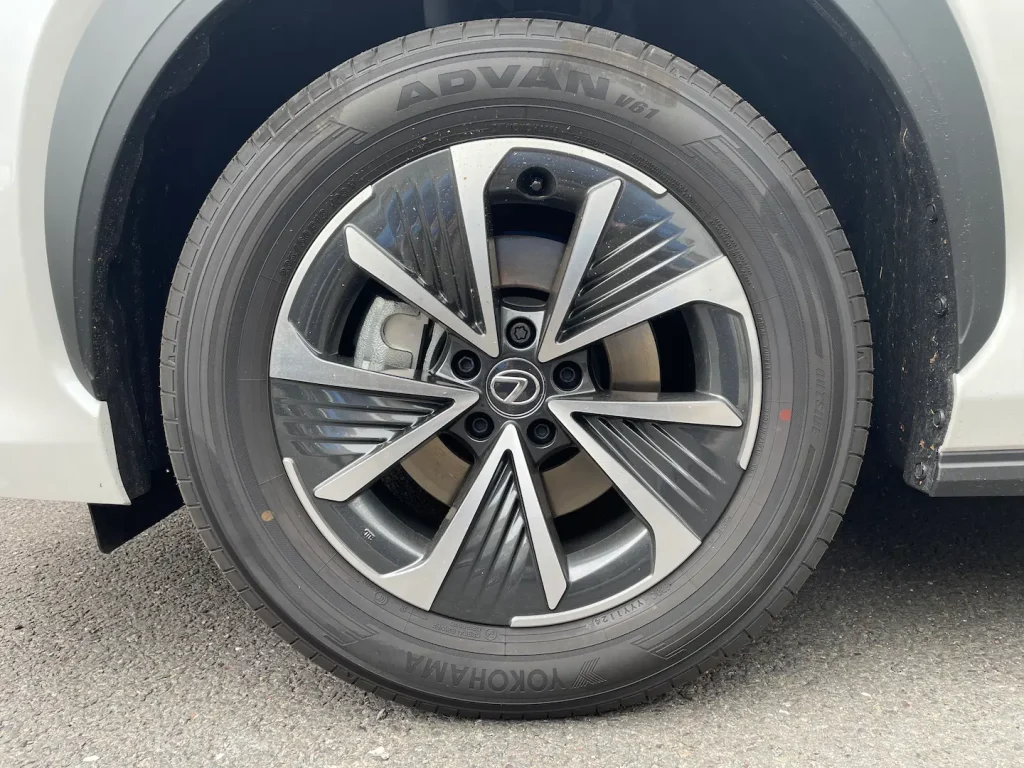
Aside from lower power and smaller wheels, the 300e in mid-range Premium 18” trim has less kit, jettisoning the panoramic view monitor, head-up display and driver seat memory setting – the latter omission already noted by my differently-sized co-driver. But it still offers a lot of tech, as is usual with Lexus, including a 14in touchscreen multimedia system, 10-speaker audio with AM/FM/DAB radio, wireless smartphone integration for Apple CarPlay (and wired for Android Auto), four USB-C charging points – two up front and two in the rear – plus a two-piece panoramic roof and a powered tailgate.
The only reporting ‘problem’ for now is that the 300e Premium 18” model is so new that Lexus hasn’t yet published official prices. Yes really. On that basis, we’re driving the future today but will update that key figure in our next report.
1st Report: All-wheel drive, all-electric large Lexus arrives
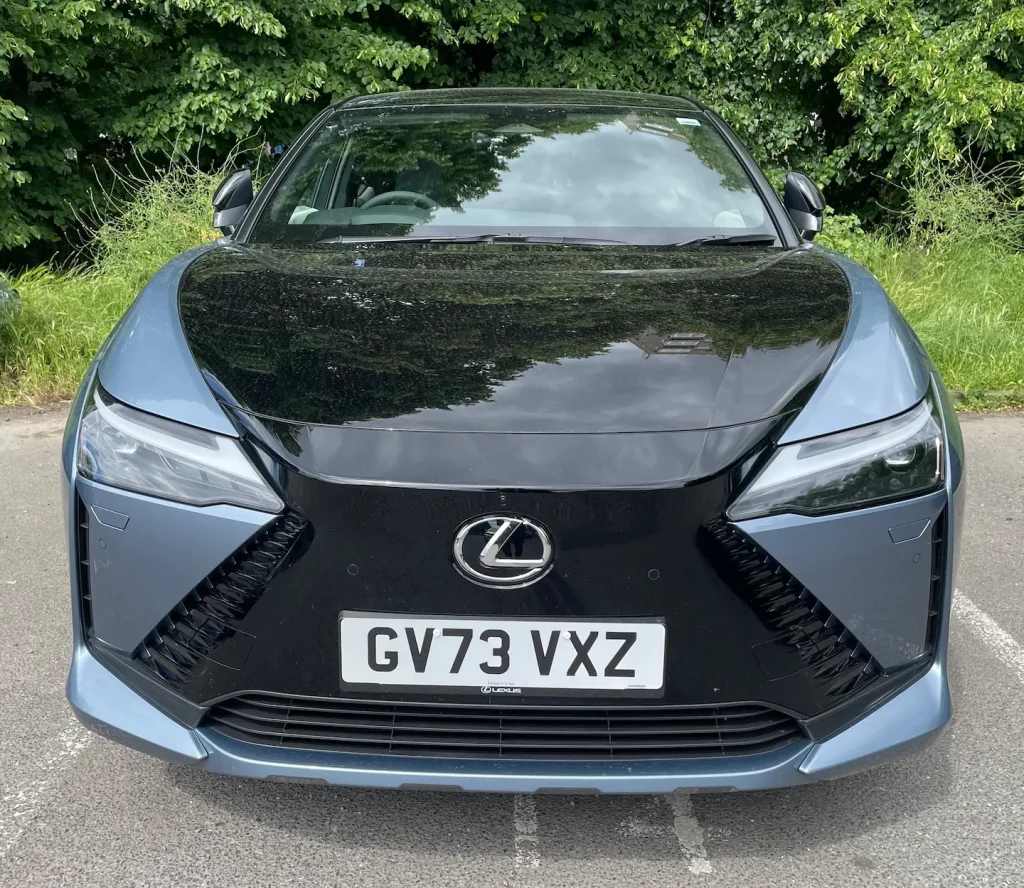
Lexus is a brand happy to take its time. But the premium Japanese marque launched by Toyota in 1989 has still come a long way in 35 years. First by gaining a reputation for build quality, reliability and customer service in the 1990s and then through pioneering petrol-electric hybrid technology in the early 00s. Latterly in the 2010s, it’s made waves with stand-out design, in particular via the angularly modern NX compact SUV, the classically curvy LC coupé and now the refined RZ mid-to-large crossover.
Launched in 2023, with the 450e all-wheel drive (AWD) model, the RZ range gains the more efficient 300e front-wheel drive (FWD) version this summer. So this long-term test begins by looking briefly at the 450e AWD model and then will compare it to the new FWD afterwards for six months.
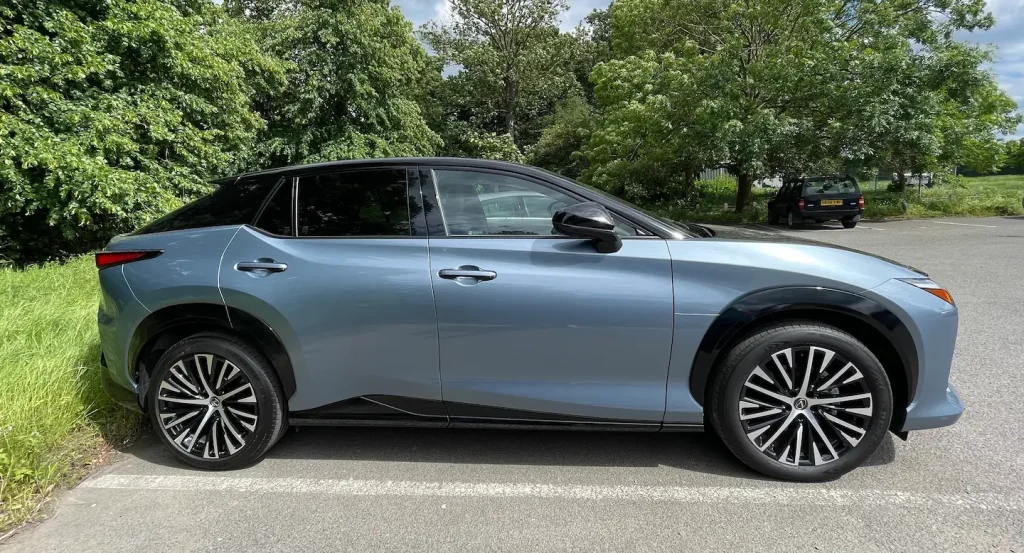
The RZ’s 4805mm length puts it at the larger end of the all-electric crossover segment. Longer than the Audi Q6 e-tron (4771mm) and shorter than the Mercedes EQE SUV (4863mm), it’s a big car, although its smart proportions hide that, through in particular, a sloping 1635mm roof, that is lower than both those German rivals. On this bi-tone model, a black gloss bonnet, door mirrors, roof, pillars, wheel arches and lower rocker panel also take visual weight out of the RZ’s bodyside, assisted by a few judiciously-placed sections of concave body sculpting, swooping back over the front wheel arch to the top edge of the rear door panel and also from the back of the front wheel arch to just beyond the vertical shut-line of the front door. You can spot these details or not, but the overall effect is – to these eyes – harmonious and, unlike some previous Lexus models, not too radical or harsh.
The interior is even calmer. All the main controls are easily within reach and the large 14in central touchscreen is angled slightly towards the driver. There’s a wide centre console area with two shapely cupholders alongside a nicely knurled gear selector, with only two major options, which after you learn to push down-and-left for Reverse and down-and-right for Drive, is simple to manage. A separate Park button north of this selector and a further park brake south, are housed neatly within the same glossy cluster plate. A special mention needs to be made of the way the matt grain wood veneer surfacing of the centre console slopes gently downwards and away from the driver to a wireless charging mat for a smartphone. It’s delightfully and seamlessly done. There are also two USB-C ports to plug into just above that, should you so choose.
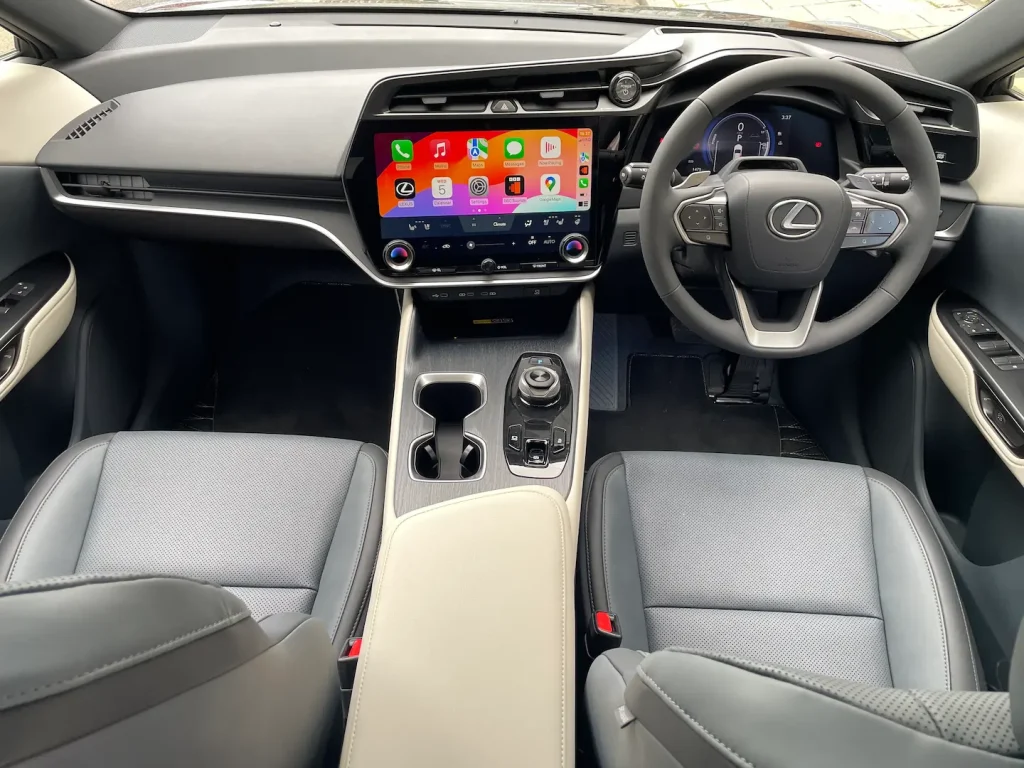
Pairing an Apple iPhone is easy, as is connecting wirelessly to fire up CarPlay, although Android Auto-compatible phones currently need to plug in. One user experience aspect that needs speedy attention once acclimatised to the car on the move, are the numerous safety and warning device levels. For instance, within the Drive Assist section of Settings in the centre touchscreen, the sensitivity of various alerts and beeps can be set to Low, Mid, or High, or turned off completely. Managing this easily will be key to a pleasant time with the car, so we will keep you posted on how we get along.
Rear seat room seems decent for passenger feet, knees and heads and that actual space is enhanced psychologically by the fixed twin panoramic roof which lets more light in and adds to the feeling of space. The boot is a reasonable 522 litres with seats up and 1451 litres seats-down, while access via the wide hatchback aperture looks generous.
Power comes from compact electric motor units front and rear that deliver a total 303hp, good for a 5.3-second 0-62mph sprint. Max speed is limited to 99mph though and the 71.4kWh battery is good for 252 miles of electric range when wearing this test car’s 20in wheels (18in versions promise 272 miles). Standard kit for the mid-range £64,640 P11D 450e Premium Plus Pack with Bi-Tone is very high – unusually there are no added options on this car. We’ll see if that price is worth it – both compared to rivals and its cheaper FWD sibling arriving soon – in due course.
Standard equipment on Premium Pack: Nine airbags, front-wheel drive, emergency brake, traction, vehicle stability and hill assist control, front and rear cross traffic alert, blind spot monitor, lane change, road sign and safe exit assist, LED headlights with automatic high beam, panoramic view monitor, front and rear parking sensors, keyless entry, dual-zone aircon with air quality system, heated front seats and steering wheel, digital colour driver display and 14-inch central touchscreen with satnav, DAB radio, Bluetooth, Apple CarPlay (wireless) and Android (wired) smartphone integration, wireless smartphone charging, four USB-C ports (x2 front, x2 rear), OTA updates, power tailgate, fixed twin panoramic roof, 10-speaker audio system, 18in wheels.
Optional equipment: Sonic White special paint (£250)
Why we’re running it: To see how the costs and driving experience stack up for the new FWD Lexus RZ variant





